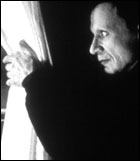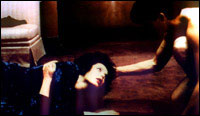 |
|
|
|
There are two points of
access and egress to the mise en scène : a door to the
immediate left of the viewer’s perspective and an opening
adjoining room that retreats into the background. This background
is almost consumed by the shadows which envelop the living
quarters ambience, and it will later serve as one of Lynch’s
staple cinematic devices : the space that engulfs its
characters, the darkness that merges with their psychological
mindsets (for examples of this, one only needs to watch Lost
Highway or Eraserhead). By depicting an environment
bathed in chiaroscuro like shadows, Lynch evokes a hostile
universe in which nothing is as it appears, and also aligns
it with one of his favourite genres, Film Noir, the shadows
mirroring the paranoia of characters thrown into a pessimistic,
bleak world. This balance of light and shadow is a master
stroke employed by Lynch as it creates the feeling of a Francis
Bacon or Edward Hopper painting moving on our screens. The
colours that do reveal themselves within these living quarters
are solemn grey-blues and pinkish reds, the overall effect
producing an ambience similar in tone to Dorothy Vallens’
apartment in Blue Velvet. Lynch seems to have
a penchant for creating interiors that have a dark foreboding
atmosphere to them, some of these interiors can be equated
with the dark troublesome exteriors of the houses depicted
in many of his paintings (9).
Lynch has said that “the home is a place where things can
go wrong” (10), and
in Rabbits the anticipation for that occurrence is
electric in its intensity.
| |
 |
|
|
From the outset of Rabbits,
the viewer is presented with a protracted scene of both drudgery
and banality coached in an almost unbearable silence :
one Rabbit is working on her domestic chore of ironing ;
continuously going over the same piece of clothing over and
over again (the first indicator of a series of repetitions
that will beset all three of the protagonists of this prison
like domicile), whilst another is sat facing towards the viewer
on a single sofa (perhaps it is a television or maybe it will
be revealed in a later episode). There is a lack of communication
between these two characters that made more intense by the
protracted length of the scene reminiscent of Hitchcock’s
Rear Window in hibernation (11).
The pacing of Rabbits is slow and deliberate, a device
employed to lull the viewer into a false sense of security.
The audience ask the questions when will something happen
and who will break the silence. The anticipation we feel is
overwhelming. All the while the viewer can hear the rain outside,
relentless and necessary to break the deafening silence that
exists between these two characters, within this functional
setting. Here we have a small area of frame to concentrate
on ; but Lynch opens up the space metaphorically and
illustrates the vast chasm of isolation that can occur between
individuals. He is testing the endurance of an audience drip
fed and weaned on synthetic, reactionary constructs of reality.
On another level it could be construed that Lynch is commentating
on the status of change that society has undergone since his
halcyon days of the 50’s : technology in the form of
television has created rifts of communication between family
members.
At this early point in the
series the viewer may not be aware that they are watching
characters who are in fact role playing the normalcy of everyday
domestic situations : families do indeed sit around for
hours without communicating, it is just that we as an audience
are not made to feel conscious of this fact because the television
has become our surrogate guardian by stealing our dependency
on intercommunication. Of course Lynch could have dissected
home life from a reverse angle and depicted endless banter
between these two characters, but this would go against his
desire to explore moods in a slow cautious manner which is
a distinct trademark of his body of work.
|